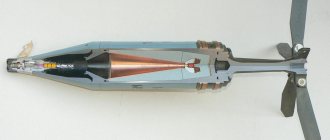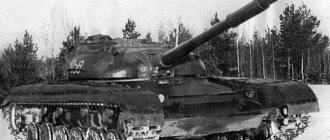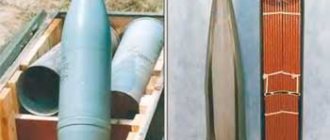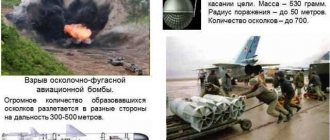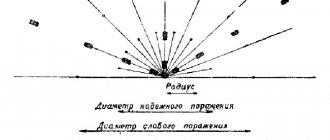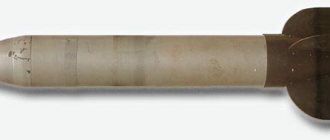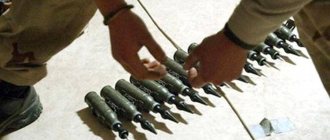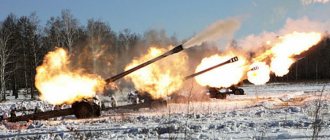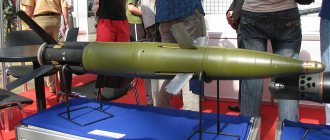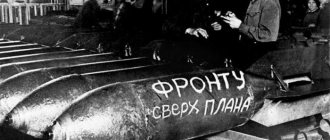Armor-piercing projectile
There are various subtypes of these ammunition: 1) Armor-piercing caliber projectiles. 2) Armor-piercing sub-caliber shells. 3) Armor-piercing feathered sub-caliber projectiles. 4) Armor-piercing cumulative shells. 5) Armor-piercing high-explosive shells.
Caliber projectiles (SBO)
German series of caliber shells.
Designed to destroy tank armor with their kinetic energy . When the armor is penetrated, the tank crew is hit by fragments of the tank's armor. Popularly, this type of projectile is simply called armor-piercing or “blank.” The projectile is solid and made of durable metal. Currently used only by backward countries , because have already been supplanted by armor-piercing feathered sabot shells.
Sub-caliber projectiles (BPS)
They are absolutely similar to SBOs, with the exception that they have a smaller caliber than the caliber of the gun, and therefore less weight. Accordingly, greater speed. Therefore, they have greater armor penetration. Currently, they are used only by backward countries, like SBO.
Feathered sabot projectiles (BOPS, OPS, OBPS)
One of the most effective means of destroying tanks at a distance of 1 km . They are an arrow-shaped core made of alloys of durable metals such as uranium or tungsten. In the bore, the core is held by a tray, which is separated after exiting the barrel. When hit, the crew is hit by armor fragments. Has enormous penetrating power . The most modern American BOPS are capable of penetrating the most advanced, according to open data, Russian Relikt remote sensing system. There is a known case when in Iraq an Abrams pierced through a T-72M1 with such a projectile from a distance of less than a kilometer. Currently, BOPS is included in every modern MBT. The shells are relatively inexpensive . They were developed in the USA at the end of the 19th century and in the USSR after the First World War. Used by the Wehrmacht from the beginning of World War II against Soviet heavy tanks.
Cumulative projectiles (CS)
Cumulative ammunition is one of the effective means of combating armored vehicles. The armor is penetrated using a cumulative jet, i.e. all the energy of the explosion comes out through a very narrow hole, which burns through the metal of the armor , i.e. its action is based on the cumulative effect, also known as the Munroe effect (the American who rediscovered the effect in 1887, the first was the Russian military engineer General Boreskov in 1864). The crew is simply being smoked out. However, cumulative projectiles are expensive and ineffective against remote sensing and cheap anti-cumulative shields . At the end of World War II, German troops used cumulative Faust cartridges, which showed high effectiveness against medium tanks. There is also a cumulative fragmentation projectile (COS) - a mixture of a cumulative and fragmentation projectile . The fragmentation effect manifests itself to a much lesser extent than the cumulative effect. There are only three tanks in the arsenal: Abrams, Leopard 2, Leclerc.
Armor-piercing high-explosive shells (APS)
Shells invented in Great Britain at the end of World War II. Initially they were used against fortifications, but then they were also used to fire at enemy tanks . Most NATO countries were armed with this ammunition in the 50s and 60s, but later they began to abandon them in favor of cumulative ones , which are much more effective. But the British don’t care about this and they are the only ones in the world who still use this type of projectile, without using cumulative ones. These projectiles have a lower cost and a longer firing range than cumulative ones.
Imperial Community: War Thunder Tank Ammunition – Imperial Community
Date: August 25, 2015, 08:44
Tables of chamber and shrapnel shells. Comparison of chamber shells 1
(expand)
Comparison of chamber shells 2
(to uncover)
BR 1.0 - 2.7
(to uncover)
Quote
Obviously, the BR-350A, which is found in the T-28, T-26-4, and Su-76M, has primacy here.
With a slight lag comes the 75mm K.Gr.rot Pz. (75mm_pzgr_rot), which is available in all early variations of the Pz IV. The American M61 clearly did not receive enough damage. The most controversial situation is with the Soviet 45mm and German 50mm. It seems that 45mm is better in terms of explosion force, but the damage radius is better with 50mm, and not too bad. T-34 World - approximately BR 3.3 - 4.3
(to uncover)
Quote
Even from the name it is clear who has the coolest shells here.
Well, not counting the 42 pieces, but everything is bad with him and the point here is not in the armor of the chamberlains, but in their armor penetration. In fact, in terms of fragmentation action, the advantage of the BR-350B is not so great, but in terms of explosion action it is simply overwhelming. The BR-350A is, of course, generally super, but its fuse is let down, some shielded groove may not be able to penetrate. A very strange situation with the Marder shell 3 (76mm_pzgr_39_rot), the damage and explosion radius are low, but the fragmentation parameters are better than even that of the BR-350A. Something is clearly wrong here, given that the Pzgr 39 rot contained only 17 grams of explosives. All other shells are approximately equal to each other and approximately equally bad, which is quite strange, because in reality the M62 and M61 have much more explosives than, for example, the pzgr 39. All together - about 4.7 - 6.7
(to uncover)
Quote
Suddenly, the M82 and BR-365A are almost equal.
BR-365K... If you have a Soviet 85mm, then forget about the BR-365K, take the BR-365A (as a last resort BR-367, if you are on a T-44). Complete horror, the same situation as with the American M61 and M62, a projectile with 60 grams of explosives was undeservedly nerfed and equated to panther projectiles with 18 grams of explosives. The German 88mm are average here - they don’t reach the M82, but they are clearly better than all 75, 76 and 85mm, except the BR-365A. The common opinion is that “100mm damage is over-extended.” IMHO this is not true. The damage from the explosion is approximately 88mm, which corresponds to the actual number of explosives in them. The fragmentation effect is greater because the caliber is larger. The explosion radius was most likely underestimated at 88mm, and not overdone at 100mm. 122, 130 and 152mm speak for themselves. Nuff Said. PS: The BR-540 is better than the BR-540B in terms of armor, although this is hardly important, the damage is still terrifying. Approximately 6.7 - 8.0
(to uncover)
Quote
The German 105mm clearly lacked the explosion radius and the radius of scattering of fragments, there was almost more explosive capacity there than in the Soviet 122mm. The German 128mm clearly lacked the explosion power, there was just a lot of explosives there. To view the link please register
. To view the link,
please register .
Concrete-piercing shells
Concrete-piercing shells are intended for firing at reinforced concrete defensive structures , strong stone and brick buildings adapted for defense, as well as strong enemy dugouts. Also, if necessary, concrete-piercing shells can be used for direct fire at tanks and other armored targets. The only modern tank in the world that has a concrete-piercing shell is the Abrams.
There are a huge variety of different ammunition in the world, which is associated with a constant arms race. This article does not contain the entire list. The following were missed: lighting, propaganda, incendiary, thermobaric, biological, chemical, nuclear shells.
HEAT projectile
The main advantage of this ammunition is that penetration does not decrease with increasing range. It operates as follows: when the cumulative charge reaches the armor, a wild pressure of a special chemical jet is applied to the small area of the armor where it was hit; as a result, due to the high temperature, the metal is burned and the jet is directed into the fighting compartment. The crew will be struck by hot fragments and the jet itself, which also contains molten metal. During the Second World War, there were known cases when cumulative ammunition did not penetrate the armor of a tank, but literally burned out the eyes of mechanical drivers who were not expecting a hit, and in this case the lungs often suffered.
In the first and second eras, only Germans and Americans have normal cumulative scores. Nevertheless, when playing the Pz IV.C, you can experience a lot of positive emotions. For the StuG III B AT, this is generally one of the main projectiles, since the armor-piercing projectile of a 75-mm “cigarette butt” does not even penetrate the T-50, not to mention the T-34.
The cumulative effect is very effective in the hands of those players who know how to target the crew and modules such as tanks or the engine. It sets fire very well, but when playing cumulative, it is worth remembering the effect of the “black ammo rack”. Sometimes it does not explode after being hit by a jet.
In the initial stages, cumulative ammunition has terrible ballistics and speed, but in the fifth era they blossom and play with new colors. After the advent of finned cumulative shells, the penetration of which exceeded 400 mm of armor, mobility, rather than armor, began to be valued at the top.
High-explosive fragmentation shells
This ammunition is used to fight infantry and enemy fortifications. High explosive shells contain much more explosive than other shells, but they have a very sensitive fuse; even a small tree branch or fence can cause the fuse to arm and subsequent detonation. Land mines also have disgusting ballistics and projectile speed. Their only advantage is splash, you can damage several modules to the enemy and kill a couple of crew members without even breaking through the armor. However, only guns with a caliber of at least 152 mm have shells of sufficient power.
Efficiency comparison table*
| FSU | BKS | BPS | KS | OFS | BFS | |
| Typical armor penetration | +++ | +++ | ++++ | +++++ | + | ++ |
| Formation of fragments/massive damage to crew | +++ | +++++ | ++ | + | +++++ | +++++ |
| Efficiency against inclined armor | +++ | +++ | + | +++ | +++++ | +++++ |
| Probability of explosion of ammunition and tanks | ++ | ++++ | ++ | +++++ | +++++ | + |
| Armor penetration at a distance | ++ | ++ | ?** | +++++ | +++++ | +++++ |
*The table is compiled based on observations using the expert assessment method.
**In World War II BPS, armor penetration at a distance dropped significantly, but in post-war ones with a detachable tray, it did not.
HESH projectile
Unlocks in the fifth era and is available to Americans as well as Germans. The principle of operation is similar to a high-explosive projectile, but with one caveat - the thicker the enemy’s armor at the point of impact, the greater the damage from secondary fragments. This is due to the fact that the projectile is equipped with a bottom fuse; when it hits enemy armor, plastic explosive spreads on it and only then does the fuse react. There is no penetration, but a lot of fragments appear from the inside, which hit the crew.
Which shells are better?
In many ways, the choice of the best ammunition depends on the specific equipment and the player himself, his preferences. In general, for a beginner, armor-piercing guns with a ballistic tip are the best choice.
There are also shrapnel and concrete-piercing shells, their implementation is completely identical to chamber shells, however, they are available only on some Soviet equipment and are no longer relevant by the time of discovery.
For the British, the best shells are sabots with a detachable sabot. Americans have had access to armor-piercing weapons since the second era, which should be actively used.
The Germans do not have much of a choice; either sub-caliber or armor-piercing ones are available; it is best to use the latter, since the former are much inferior to analogues of other nations, constantly ricocheting.
MILITARY REVIEW AND POLITICS
Introduction
The eternal theme of projectiles and armor has received a new lease of life due to the wide spread of one game in which tanks stupidly go at each other, and the strength of the armor supposedly directly depends on the amount of money the player has. I want to tell you about the true state of things. After all, armor can be very different; the thickness of the armor being penetrated depends not only on the initial speed of the projectile, but also on its quality. At the same time, we’ll figure out why the shells of our forty-five millimeter cannons did not always penetrate the armor of German tanks thirty millimeters thick. And how the Germans fought our tanks with a thirty-seven millimeter anti-tank gun.
Armor
Armor must have two mutually exclusive qualities - hardness and toughness. Against a small-caliber projectile, just very hard armor is enough. With a medium-caliber projectile, the armor must be not only hard but also viscous. For a large-caliber projectile, the viscosity of the armor comes first. Because a large-caliber projectile can simply split an armored part of a turret or hull if it does not have enough toughness. Therefore, oddly enough, the hardness of tank armor decreased all the time during the Second World War. It’s just that hardness and toughness are difficult to reconcile.
Here are photographs of German tanks. The top photo shows traces of being hit by shells of different types (more on this below) and different calibers. Cracks spread out from the holes of large-caliber shells; small-caliber shells simply pierced the armor. There are no cracks in the middle photo; a large-caliber shell simply destroyed the tank's turret. In the bottom photo, a one hundred and fifty-two millimeter caliber shell hit the very edge of the tank’s hull under the turret. The shell simply hit the edge of the hull and flew away. And there is a chalk circle around the part of the body that simply fell out from this blow. If you look at the outline outlined in chalk, the hit was in the upper right corner. Part of the hull in that place flew away along with the projectile. The firing distance is written next to it - one thousand two hundred meters. That is, the speed of the projectile was no longer very high, but fifty kilograms of weight did the job.
The photo shows the turret of our tank. For the purpose of the experiment, I think they fired at it from a German anti-aircraft gun with a caliber of one hundred and twenty-eight millimeters; there was simply nothing more powerful at hand. Through holes and not a single crack.
You can combine high hardness and toughness by making armor of two layers. The upper hard layer gradually turns into a viscous underside. This type of armor is called heterogeneous. The secret to producing such armor is very simple. The metal surface is simply saturated with carbon and then hardened. But this is simple in words, but in reality carbon penetrates the metal very slowly. To do this, the sheet is heated in an oven, sprinkled with a composition containing carbon and wait. And they wait a week, if not more. Have you calculated how much gas will be burned in a week and how much it will cost? So the armor of German tanks in the initial period of the war was exactly like this. The quality of German armor was the highest in the world. The composition of the armor is no secret; it is iron with the addition of carbon and manganese, about three percent nickel, up to two percent chromium. Quality depends on the presence (or rather, absence thereof) of harmful impurities such as sulfur and phosphorus. Nickel and chromium increase toughness and accelerate the process of carbon saturation of steel. Molybdenum and especially vanadium are even more effective as alloying elements, but where to get them? The Germans almost ran out of nickel by the end of the war, which is why the turrets of their tanks were cracking, and not because our guns were very powerful. Armor obtained by rolling or forging is of better quality than cast. The gain in thickness with equal durability is approximately ten percent. Cast armor is prone to cracking. Rolled armor has a different problem. If you weld a turret or tank hull from its sheets, then in the area of the seam the strength drops by ten percent.
Armor-piercing shells
Armor-piercing shells come in three types. An ordinary solid steel blank. A regular blank with a ballistic tip attached to it, which improves the aerodynamics of the projectile. An ordinary blank on which an armor-piercing cap and a ballistic tip are put on.
When hit at a ninety-degree angle, all projectiles have virtually the same effectiveness. But this doesn’t happen in life. Therefore, the most effective is a projectile with an armor-piercing tip. The tip itself is a cap made of soft metal. In case of an oblique hit, it sticks to the armor and prevents the projectile from sliding off. At the same time, the process of turning the projectile to the vertical occurs. Moreover, the longer the projectile, the more active the finishing is. The armor-piercing tip also to some extent prevents the destruction of the armor-piercing core. A small historical digression. The armor-piercing cap was invented in Russia. But the shells in the Red Army were the simplest - blanks hardened to high hardness. A justification was even given for this. German tanks did not have sloped armor, which is why we made simple shells. In fact, the reason was the lack of production. Not many people know that the production of shells takes up many more resources than the guns themselves. We were blanks and barely had time to do it. When the war began, it turned out that the shells did not penetrate German armor, they simply split apart from the impact. They began to talk about a violation of the technological process of hardening. Some people were shot. But it seems to me that the whole point was the excellent German armor. It had an abnormally hard top layer and a soft underside. For forty-five millimeter caliber shells of the available quality, it was simply too tough. The solution was found completely unexpectedly. They began to make shallow circular grooves on the shells. They are marked with the number seven in the photograph. In some way that was completely incomprehensible to me, they began to prevent the destruction of the projectile body.
Here are German armor-piercing shells. Ballistic tip and armor-piercing cap are all present. Of course, the weapon itself was rather weak, but the main thing was desire. Search the Internet for MACHINE GUN UTOS and they will tell you how one militiaman used it to knock out two Ukrainian T-64 tanks. The most important thing is that the Germans almost immediately stopped shooting our tanks in the forehead. When examining destroyed tanks, there were practically no traces of hits on the frontal armor. The tanks were simply allowed into the dense area and fired at the side. Since our tanks were practically blind and often went on the attack without infantry support, the losses were significant. The Germans fired even when they were sure that the shells would not penetrate the armor. For what? Numerous hits jammed the turret, broke a few observation devices, and quite often pierced the gun. Why do you think the tiger got gun armor? The Germans simply took into account the statistics of their hits on our tanks. True, the German anti-tank guns also suffered. This was the only type of gun in which the Germans suffered catastrophic losses in the initial period of the war.
Here is the entire range of German armor-piercing shells. As you can see, there are simply no blanks in principle.
Here are our eighty-five millimeter shells. At best, there is a ballistic tip.
Here are our one hundred and twenty-two millimeter caliber shells. On the left is a simple blank on the right, slightly, I emphasize slightly, improved. The first penetrated the frontal armor of the tiger at a distance of one thousand two hundred meters, the second at a distance of one thousand eight hundred meters. Here is a clear example of the different capabilities of shells of different designs.
Sub-caliber armor-piercing shells.
The entire effect of a sub-caliber projectile follows from a physical formula, which states that the energy of a projectile depends on its speed twice as much as on its weight. Therefore, the weight and diameter of the armor-piercing core was reduced, and a light pallet guided it along the barrel. At first, the pallets were not detachable and after the projectile left the barrel they immediately began to slow it down. Therefore, during the war, sub-caliber shells penetrated a large thickness of armor only at short distances.
Here is the same photo of the tower again. The impact points of sub-caliber armor-piercing shells can be recognized by specific marks - a small crater on the armor (from a hit by a sabot) with a small diameter hole in the center. For armor-piercing cores of sub-caliber projectiles, a problem arose with the quality of the metal from which they were made. At high speeds, the cores simply split without having time to penetrate the armor. The best turned out to be a tungsten core (heavy, durable) with the addition of nickel and copper to increase viscosity. But everything, as usual, comes down to price. Can you imagine how many light bulbs need to be broken to collect tungsten for one armor-piercing core? Another option is depleted uranium. I thought for a long time how this uranium was depleted? It turned out that it was just waste from the production of nuclear weapons. Uranium from which radioactive isotopes have been extracted is called depleted. Armor-piercing cores became long and thin. An armor-piercing cap is required. Sometimes it simultaneously serves as an aerodynamic cap. Modern armor-piercing cores of sub-caliber projectiles with a detachable tray practically do not react to the slope of the armor. On average, at a distance of two thousand meters, armor with a thickness of three hundred millimeters installed at an angle of sixty degrees is penetrated. The defense once again lost to the attack.
There is a separate article on the website about cumulative shells.
Chamber projectile
A chamber projectile differs from a conventional armor-piercing projectile by the presence of a cavity (chamber) that contains explosives. The projectile itself is equipped with a fuse that is triggered when the ammunition overcomes a certain thickness of armor. When penetrated, secondary fragments are formed, damaging equipment and injuring the crew. After flying a certain distance (each shell had its own detonation time, the fuses also differed in sensitivity) the chamber exploded, killing everyone in the fighting compartment.
Such shells are used mainly on Soviet vehicles. Despite the fact that chamber shells have slightly lower penetration than conventional armor-piercing shells, this is quite easily compensated for by the caliber of Soviet guns. The D-25-T, used on heavy tanks like the IS-2, has well over 200 penetration. The armor effect is enough to destroy any tank in the game with one shot.
Aircraft chamber projectiles act similarly. When hit in the wing, if the fuse is armed, the player will be able to watch the beautiful fall of the enemy aircraft. Just a couple of hits will be enough. The chamber projectile will be especially effective against bombers.
Practical projectile
The practical projectile is used in aviation to teach pilots the basics of shooting. They are used mainly by the Japanese in the game. The practical projectile itself is created from softer materials than armor-piercing ones, and if the enemy has a poorly protected aircraft, the damage will be quite serious. Practical shells work well against biplanes, but when using a belt with similar ammunition, it’s better not to even look at bombers and attack aircraft - it’s a waste of shells.
